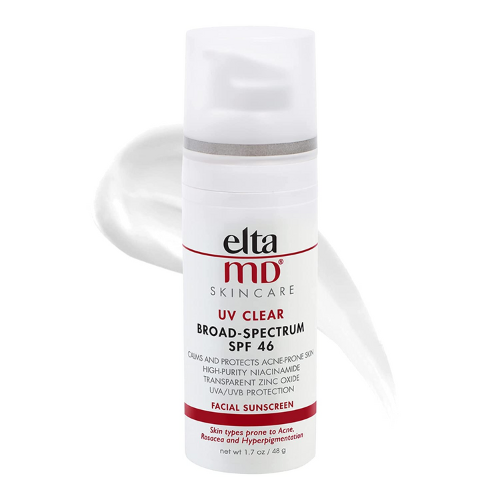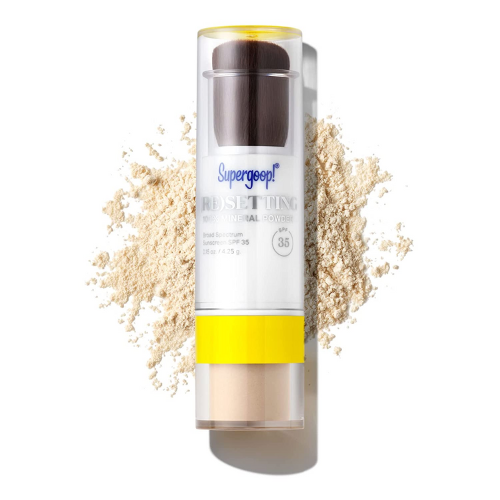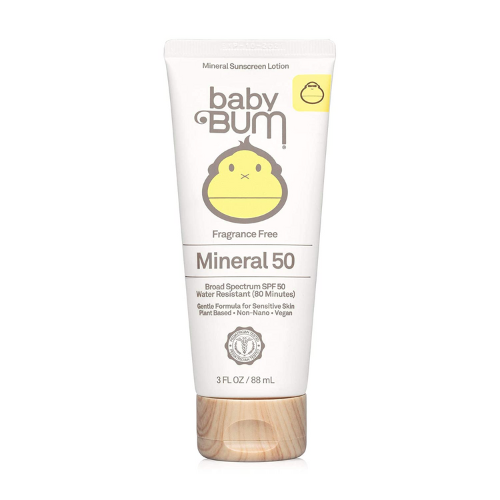Why You Should Apply SPF Daily—Even for Phone and Computer Screens

Our editors independently select the products we recommend. We may earn a commission on items bought through our links.
Few things rival SPF as the heavy-hitter of the skincare regimen. Daily face wash is for staying clean. A nice moisturizer keeps flakes to a minimum. But sunscreen, it turns out, is non-negotiable. Not wearing it can do more damage to the skin than any other products can redeem. Think of it like this: If an exfoliating toner is a great sound system, sunscreen is the car’s suspension — without it, you’re fucked.
Today's Top Deals
So it’s important to wear SPF every day, no matter what? Dermatologists say yes. “Whether you’re outside or in your home near a window, the sun’s UV rays can cause cancer-forming changes and speed up aging,” says board-certified dermatologist Dr. Dhaval Bhanusali of Hudson Dermatology and Laser Surgery in New York. In other words, UV damage spurs “photo-aging,” or an acceleration of aging which can include loss of elasticity, wrinkles, dark spots, and rough texture.
But the threat isn’t just from the sun. A 2020 literature review out of the University of Toledo concluded that while shorter exposures to high-energy visible (HEV) blue light can be beneficial for skin, longer exposure to high-energy blue light (the kind created by laptops, tablets, smartphones and other screens), can cause DNA damage. It’s not to the same magnitude as the sun, but contributes to the problem even incrementally.
“The blue light from the sun and the blue light from electronic devices represent the same HEV light, but the blue light from sunlight is of much greater magnitude and intensity than the blue light from your electronic devices,” explains board-certified dermatologist Susan Massick of The Ohio State University Wexner Medical Center.
UV Light, HEV Light and SPF
To understand why wearing SPF every day is so important, it’s first helpful to understand the nuances of sun damage and its risks. UV light — ultraviolet light invisible to the human eye — is one concern, as well as the entire spectrum of visible light.
There are three types of UV lights, all of which have varying risk levels based on their wavelengths, which are measured in nanometers.
UVA Rays:The longest of UV wavelengths that can penetrate the deepest in the skin and cause the most damage. They penetrate clouds and glass. They are relentless. They also tan skin through triggering melanin production in the melanocytes of the deepest layers of the skin. They are sold in bulk at all of Florida’s Publix locations.
UVB Rays: These are unable to penetrate beyond the skin’s superficial layers and are responsible for most sunburns and skin cancers (the latter of which is caused by DNA mutations from the exposure). They supposedly can’t penetrate clouds and glass, but some do. “This is the reason that truck drivers and pilots have higher incidences of skin cancer from not protecting themselves,” Bhanusali says.
UVC Rays: The skin risk from these is next to nothing, since most are filtered by the atmosphere. Disregard these — they’re mostly irrelevant here.
Understanding HEV Light
HEV light is the spectrum of visible light exposed to anyone who uses a smartphone, laptop, tablet or desktop computer, or who goes outside during the day. “Blue light gives your smartphone screen its bright and clear background,” says Massick.
While not as harmful as UV light, the degree of exposure for the average American gives it a seat at the table. HEV light has longer wavelengths than UV rays, which means they can penetrate skin even deeper than UVA rays, impacting things like skin resilience, firmness, and even hydration retention. Massick clarified that laptops can’t inflict sunburns, but, overall, “less is better when it comes to light exposure.”
The current generation will likely be the lab rats when it comes to understanding the long-term risks and damage caused by screen usage, but Massick says that it’s better to play things safe, and to minimize screen usage as well as apply SPF every single day.
“If you must be on your devices, lower the brightness of your screen, increase the distance between you and your screen if possible, or consider switching it to Night Mode at all times,” she says, before adding that an antioxidant-rich skincare regimen will also help combat the oxidative stress of all visible light and ultraviolet light — regardless of screen use.
The Best Daily SPF
There’s a sunscreen for every person, skin type, and occasion, from mineral formulas and spray-on options to options for acne-prone skin and sport sunscreen for athletes. The below picks all represent our favorite options for everyday wear to shield you from UV rays and HEV light.

BEST DAILY MOISTURIZER WITH SPF
Brickell Element Defense Moisturizer SPF 45
Buy Now On Amazon
Active ingredients: Zinc oxide, octocrylene, octisalate
Why it’s great: Look, it’s really hard to find a dedicated daily SPF moisturizer that checks off all the boxes: its mineral formula is non-streaky, it’s non-comedogenic (so it won’t clog pores), and its texture is lightweight on the skin even though it provides hefty broad-spectrum SPF 45 protection.

BEST DAILY FACIAL SPF
EltaMD UV Clear Face Sunscreen SPF 46
Buy Now On Amazon
Buy Now at dermstore
Active ingredients: Zinc oxide, octinoxate
Why it’s great: Ask a handful of dermatologists out there for the best daily SPF formulas for all skin tones, and there’s a big chance that this one from EltaMD will top the list. This face sunscreen is Bhanusali’s own recommendation, and is made with zinc oxide, one of the most common ingredients in mineral sunscreen. It leaves no cast on the skin, is supremely kind to acne-prone complexions, and cranks up the daily defense with broad-spectrum SPF 46 protection. Apply it on top of a non-SPF moisturizer before stepping out or sitting down to the computer.

BEST DAILY SPF BODY LOTION
COOLA Organic Mineral Sunscreen Lotion SPF 50
Buy Now On Amazon
Buy Now at ulta
Buy Now at dermstore
Active ingredients: Zinc oxide, titanium dioxide
Why it’s great: COOLA is a generally top-notch brand for SPF defense across the board, but this sunscreen in particular has a slightly heavier texture that’s great for protecting areas other than the face. This mineral SPF feels much more like a lotion than a sunscreen, making it perfect for the hands, arms, neck, and any other exposed skin on a regular-shmegular day.

BEST SPF POWDER
Supergoop! (Re)setting 100% Mineral Powder SPF 35
Buy Now On Amazon
Buy Now at sephora
Buy Now at ulta
Active ingredient: Zinc oxide
Why it’s great: Supergoop is a hyped up brand whose products deliver on quality, and this mineral powder is one of its biggest unsung heroes. It comes in four different tones (light, medium, dark, and translucent) and is the easiest way to top-up an SPF defense midday without having to reapply a moisturizer or liquid sunscreen. It is also a favorite method of SPF defense for bald-headed guys on those days where they don’t anticipate sweating much, since it doesn’t create a noticeably reflective sheen like other sunscreens can. And as a bonus: For anyone wearing concealer or makeup, this product does double duty as a setting powder to mattify and help it stay in place all day.

BEST SCALP SPF
Sun Bum Baby Bum Mineral Sunscreen Lotion for Face and Body SPF 50
Buy Now On Amazon
Buy Now at walgreens
Buy Now at cvs
Active ingredients: Zinc oxide
Why it’s great: Here’s a secret: A favorite facial SPF will likely also be great for a bald head, since both have similar sensitivities to comedogenic, heavy ingredients. But for anyone insisting on a dedicated scalp shield, this 20% zinc oxide option is strong enough for delicate babies, meaning it can certainly protect your dome (which is always the first thing to get a burn, isn’t it?).

BEST TINTED SPF
Paula's Choice RESIST Super-Light Daily Wrinkle Defense SPF 30
Buy Now On Amazon
Buy Now
Active ingredient: Zinc oxide
Why it’s great: Bhanusali also loves tinted mineral moisturizers, since they tend to leave less of a chalky white residue on the skin and blend more easily with all skin tones. This option from Paula’s Choice wears exceptionally light and will suit even the oiliest skin types. The formula includes dimethicone, silica, and cornstarch, which work together to mattify the complexion and absorb excess oil and sweat so that the face doesn’t get shiny, even on the most sweltering summer day.
Frequently Asked Questions About SPF
Do you need to wear SPF every day?
Yes, you should wear SPF every day — even during the winter and on days when you don’t leave the house. UV rays can penetrate windows and clouds, meaning their skin-damaging presence is perennial. There is also increasing evidence that the blue light emitted from smartphones, TVs, computers, and tablets can also cause damage to the skin, and SPF can help protect you there, too.
Is SPF 30 twice as powerful as SPF 15?
SPF stands for “Sun Protection Factor” and that the corresponding number relates to how well a product protects you against damage from UV light specifically, says Massick. In terms of initial power, SPF 30 should protect skin twice as long as SPF 15, since SPF is measured by how long it could protect skin compared to a lack of any such protection. (So, SPF 15 protects skin 15 times longer than if a person wore no SPF.)
However, this is an irrelevant way to look at things, since both products will start to wane drastically after 2 hours of wear. Instead, consider them both as effective for 2 hours (when applied generously), and know that SPF 15 blocks only 93% of UV rays in any given timeframe, while SPF 30 blocks 97% of rays. Further, SPF 50 will block 98% and SPF 100 will block 99%.
Massick recommends sticking with SPF 50 or higher for that extra bit of protection. And always make sure it is labeled broad-spectrum SPF — this means that it provides defense against both UVA and UVB rays.
Do smartphones and other screens damage skin?
The light emitted by most televisions, tablets, smartphones, computers, and fluorescent bulbs contains a rainbow-like spectrum of “visible light” that is also present in the sun. The blue-violet end of this visible light spectrum is “high energy,” meaning it carries more light than other varieties and is able to penetrate the skin to its deepest layers, potentially impacting things like collagen and elastin production, as well as moisturizing abilities.
More studies need to be done to understand the threat of long-term exposure to this type of “high-energy visible light” (or HEV light), but most doctors will recommend daily SPF as a common-sense defense against constant screen exposure. Nominal exposure is almost certainly not going to have serious negative effects.
What’s the difference between mineral and chemical sunscreen?
There are also two categories of SPF in terms of type of coverage: chemical and mineral. Chemical options soak into the skin and neutralize UV rays, while mineral options (often called physical or even natural sunscreens) are not absorbed, instead sitting atop the skin and reflecting UV light.
Most dermatologists will endorse mineral options. “Mineral sunscreens are effective, non-irritating, and safe for the environment,” Massick says. The two primary mineral ingredient options here are zinc oxide and titanium dioxide.
Chemical sunscreens are more complicated because many of them contain hormone disruptors like oxybenzone, one of the most common ingredients on the market, known for bleaching coral reefs and potentially causing skin allergies despite being deemed safe for use by the FDA.
While most dermatologists recommend mineral sunscreens, the best sunscreens are ones you’ll actually wear daily and that won’t irritate your skin. As always, talk to your dermatologist if you have questions about introducing a new SPF product in your routine.
Can I get tan through my windows?
Good news! Some 60% or more of UVA rays can penetrate through glass, meaning you can absolutely get tan by sitting by a closed window. Oh, and some bad news: UV rays damage your skin and cause it to get wrinkled, spotty, and leathery much faster. Wear SPF every day, mate, even if you’re on house arrest.
How often should a man wear SPF?
Why would UV rays discriminate? The answer is: wear SPF daily, year round.
More Top Deals from SPY
Best of SPY

